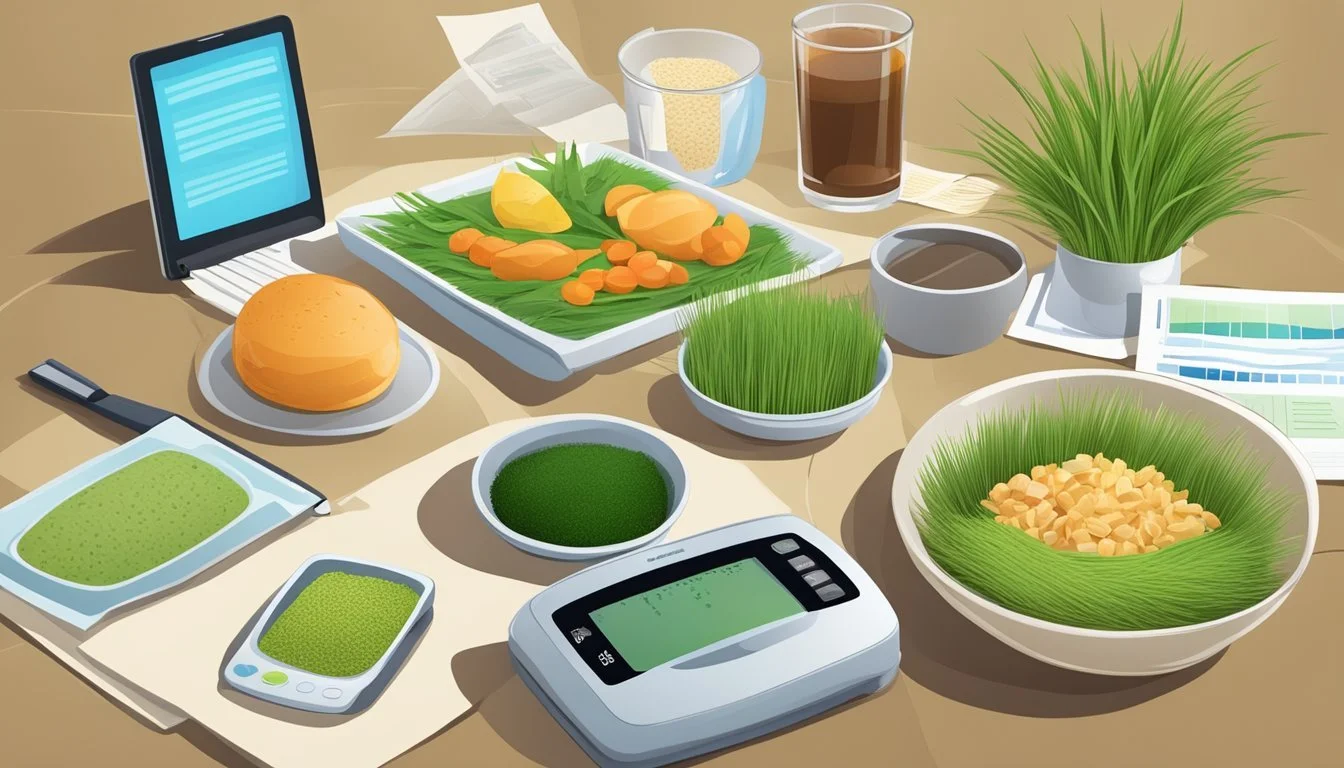Can Diabetics Eat Wheatgrass?
Benefits and Risks Explained
Wheatgrass offers significant potential benefits for people with diabetes. Studies suggest that wheatgrass can improve glucose and lipid levels effectively, aiding in the management of diabetes. Including wheatgrass in a diabetic diet can help stabilize blood sugar levels and potentially reduce the risk of heart disease by lowering bad cholesterol and enhancing good cholesterol.
Moreover, wheatgrass is rich in nutrients and antioxidants, making it a valuable addition to any diet. Its neuroprotective properties may also support cognitive function, with some research pointing to its benefits for mental health. Diabetics seeking natural ways to manage their condition may find wheatgrass to be a beneficial supplement.
Apart from internal benefits, wheatgrass can also be topically applied to help with wound healing, which is crucial for diabetics prone to ulcers. With these advantages, wheatgrass presents itself as a multifaceted option for those looking to improve their health while managing diabetes.
Understanding Diabetes
Diabetes is a chronic condition affecting how the body processes blood sugar (glucose). It is characterized by high levels of blood sugar, which can lead to serious health problems if not managed properly.
There are two primary types of diabetes: Type 1 and Type 2.
In Type 1 diabetes, the pancreas produces little or no insulin, a hormone that regulates blood sugar levels. This type often develops during childhood or adolescence.
Type 2 diabetes is more common and typically occurs in adults. In this form, the body becomes resistant to insulin or doesn't produce enough. Factors like poor diet, lack of exercise, and obesity can increase the risk.
Insulin is crucial for diabetes management because it allows cells to absorb glucose from the bloodstream. Without effective insulin regulation, blood sugar levels can become dangerously high.
Elevated blood sugar levels over time can lead to complications such as:
Nerve damage (neuropathy)
Kidney damage (nephropathy)
Eye damage (retinopathy)
Monitoring and managing blood sugar levels are essential to prevent these complications. Diabetes management often involves:
Medication: Insulin injections for Type 1 and various drugs for Type 2.
Diet: Emphasizing whole grains, lean proteins, and vegetables.
Exercise: Regular physical activity to maintain a healthy weight and improve insulin sensitivity.
Understanding diabetes and its management is vital for those affected by the condition. Effective control of blood sugar levels can significantly reduce the risk of complications and improve quality of life.
Overview of Wheatgrass
Wheatgrass, derived from the young shoots of the wheat plant, is renowned for its rich concentration of essential nutrients and its historical medicinal use.
Nutritional Profile
Wheatgrass is packed with a diverse array of vitamins and minerals. It contains high levels of vitamins A, C, and E, all of which are potent antioxidants. Additionally, wheatgrass is a source of various B vitamins, including B1, B2, B3, and B6.
The plant is also rich in minerals such as iron, calcium, magnesium, and potassium. These nutrients support various bodily functions, from bone health to muscle function.
Beyond vitamins and minerals, wheatgrass includes a significant amount of chlorophyll, which is believed to have detoxifying properties. It also contains protein, supplying essential amino acids that the body cannot produce on its own. Various enzymes present in wheatgrass contribute to its role in promoting digestive health.
Historical Use and Popularity
Wheatgrass has a long history of use in traditional medicine, particularly within ancient Egyptian and Indian cultures. These civilizations recognized its health-enhancing properties and used it to boost energy levels and treat various ailments.
It gained modern popularity in the 1930s when agricultural chemist Charles F. Schnabel began advocating its benefits. Since then, wheatgrass has been incorporated into numerous health products, including juices, powders, and supplements.
The resurgence in interest is largely due to its endorsement by health enthusiasts and celebrities, who praise it for its detoxifying and energizing effects. Today, wheatgrass is widely available in health food stores and is a common ingredient in smoothies and wellness shots.
Health Benefits of Wheatgrass
Wheatgrass is a nutrient-dense herb often touted for its potential health benefits. From blood sugar management to digestive health, it offers several advantages that are especially relevant for managing diabetes.
Blood Sugar Management
Wheatgrass may help regulate blood sugar levels, which is crucial for diabetics. Animal studies have shown that wheatgrass may lower blood glucose levels. This can be particularly beneficial for Type 2 diabetics who struggle with elevated blood sugar.
Potential mechanisms include improved insulin sensitivity and a decrease in blood sugar spikes. While human studies are limited, the findings are promising. Including wheatgrass in a diabetic diet could offer additional support alongside traditional treatments.
Anti-Inflammatory and Antioxidant Effects
Wheatgrass contains anti-inflammatory properties and is rich in antioxidants. These components can help reduce inflammation, which is a significant issue in diabetes management.
Inflammation can exacerbate various complications related to diabetes, including cardiovascular disease. Antioxidants in wheatgrass, such as flavonoids and vitamins A, C, and E, combat oxidative stress by neutralizing free radicals. This dual action helps in reducing both inflammation and cellular damage.
Digestive Health
Digestive health is another area where wheatgrass excels. Rich in fiber, it aids in smooth digestion and helps regulate bowel movements. This can prevent constipation, a common issue for many diabetics.
Additionally, wheatgrass contains enzymes like protease and amylase, which aid in the digestion of proteins and carbohydrates. These enzymes can facilitate better nutrient absorption, which is vital for overall health and maintaining stable blood sugar levels.
Cardiovascular Benefits
Heart health is a primary concern for diabetics, and wheatgrass offers several cardiovascular benefits. It has been shown to reduce cholesterol levels, including low-density lipoprotein (LDL), which is often referred to as "bad" cholesterol.
Reducing LDL levels helps decrease the risk of heart disease. Additionally, wheatgrass may increase high-density lipoprotein (HDL) or "good" cholesterol. Together, these effects contribute to a healthier cardiovascular system, lowering overall risk factors associated with diabetes.
Cancer-Fighting Potential
Wheatgrass is also studied for its cancer-fighting potential. It contains compounds that may help prevent the growth of cancer cells. Elements like chlorophyll and various phytochemicals have been shown to have anti-cancer effects in laboratory studies.
These compounds can inhibit the proliferation of cancer cells and induce apoptosis, or programmed cell death, in malignant cells. While more research is needed, the early evidence suggests wheatgrass could be a helpful adjunct in cancer prevention strategies.
Wheatgrass and Diabetes
Wheatgrass has shown promise in managing diabetes by influencing blood sugar and insulin levels, as well as improving lipid profiles. Its potential benefits make it an area of interest for those with type 2 diabetes.
Impact on Blood Sugar and Insulin
Wheatgrass may positively affect blood sugar and insulin levels. According to some studies, incorporating wheatgrass into the diet could help lower blood sugar levels.
In a study conducted with rats, wheatgrass demonstrated a blood sugar-lowering effect, suggesting potential benefits for type 2 diabetes. By potentially reducing glucose levels in the blood, wheatgrass can aid in diabetes management.
Wheatgrass may also impact glycemic index. Foods with a lower glycemic index do not spike blood sugar as rapidly, which is beneficial for diabetics. Utilizing wheatgrass might help control blood sugar spikes and enhance insulin sensitivity, thereby providing support in diabetes management.
Lipid Profile and Diabetes
Wheatgrass could also influence the lipid profile, which is often a concern for diabetics. Diabetes can lead to increased cholesterol levels, heightening the risk of cardiovascular issues. Some research indicates that wheatgrass may help manage these levels.
By reducing "bad" cholesterol (LDL) and potentially increasing "good" cholesterol (HDL), wheatgrass contributes to better lipid management. Improved lipid profiles can reduce the risk of heart disease, a common complication in diabetes.
In summary, wheatgrass may offer benefits for managing blood sugar, insulin sensitivity, and lipid profiles, which are critical factors in diabetes care.
Consumption Guidelines
Wheatgrass can offer several health benefits for diabetics, including improved digestion and possible regulation of blood sugar levels. It is important to adhere to recommended dosages and consider various forms available for consumption.
Recommended Dosages
For most individuals, the recommended dosage of wheatgrass juice is 1-2 ounces per day. This amount can be split into smaller servings throughout the day to avoid potential digestive issues.
When consuming in powdered form or tablets, follow the manufacturer's guidelines, which usually suggest a daily intake ranging from 3-5 grams. Adjustments can be made based on personal tolerance and medical advice.
Forms of Wheatgrass
Wheatgrass is available in several forms, including juice, powdered form, tablets, and fresh sprout. Fresh juice is often considered the best option due to its nutrient density.
Powdered wheatgrass is convenient for adding to smoothies or beverages. Tablets and capsules offer a simple, mess-free way to include wheatgrass in daily routines.
Dietary Integration
Incorporate wheatgrass into your diet by adding juice to smoothies or consuming it directly. The powdered form can be mixed with water, juices, or added to recipes such as vegetable dishes or soups.
Wheatgrass tablets can be taken with meals or as directed by a healthcare professional. Ensure to start with small doses and gradually increase to monitor how your body reacts.
By following these guidelines, diabetics can safely and effectively include wheatgrass into their dietary regimen.
Potential Risks and Side Effects
Wheatgrass can offer numerous health benefits but may also pose some risks. It is essential to be aware of potential side effects such as nausea and headache, allergens for those with sensitivity, and interactions with various medications.
Managing Side Effects
Common side effects of consuming wheatgrass include nausea, headache, and diarrhea. These symptoms can occur if wheatgrass is consumed in large quantities or if the body is not used to it.
To manage these side effects, it is recommended to start with small doses and gradually increase the amount. Drinking ample water and taking wheatgrass on a full stomach can help mitigate nausea and digestive issues. Pay attention to any side effects and consult with a healthcare provider if they persist.
Wheatgrass Allergens and Gluten Sensitivity
Wheatgrass is generally gluten-free, making it safe for those with gluten sensitivity or celiac disease. However, people with wheat allergies may experience allergic reactions like rashes or breathing difficulties.
To avoid allergic reactions, individuals with wheat allergies should steer clear of wheatgrass products. Reading labels and consulting with healthcare professionals can help ensure that the wheatgrass consumed is free from cross-contamination with gluten-containing products.
Interaction with Medications
Wheatgrass contains high levels of vitamin K, which can interfere with blood-thinning medications like warfarin. Those on such medications should consult their doctors before consuming wheatgrass.
Other potential interactions include affecting the efficacy of medications for diabetes. It is critical to monitor blood sugar levels closely and adjust medication dosage as needed. Always discuss with a healthcare provider to understand specific risks associated with wheatgrass consumption while on medication.
Lifestyle Considerations for Diabetic Patients
Regular exercise and a balanced diet are crucial elements in managing diabetes effectively.
Importance of Regular Exercise
Engaging in regular exercise is essential for individuals with diabetes. Physical activity helps regulate blood sugar levels, improve insulin sensitivity, and reduce the risk of cardiovascular diseases. It also aids in weight management, which is significant for diabetic patients, as obesity can exacerbate their condition.
Regular exercise, such as brisk walking, swimming, or cycling, for at least 150 minutes per week is recommended. Strength training exercises should also be incorporated to enhance muscle mass and metabolic rate. Proper planning and hydration during exercise are vital to avoid hypoglycemia.
Balanced Diet and Healthy Eating
Maintaining a balanced diet is fundamental for diabetes management. Consuming a variety of nutrient-dense foods can help control blood sugar levels and support overall health. Diabetic patients should focus on eating whole grains, lean proteins, healthy fats, and a wide array of vegetables.
Monitoring carbohydrate intake is crucial since excessive carbs can spike blood sugar. High-fiber foods, such as legumes and whole fruits, are beneficial as they aid in sustained energy release. Reducing processed foods and sugars lowers the risk of heart diseases often associated with diabetes.
Meal planning and portion control are key strategies to prevent hyperglycemia and ensure balanced nutrition.
Comparing Wheatgrass to Other Superfoods
Wheatgrass is often praised for its potential health benefits, particularly for diabetics, but how does it compare to other superfoods?
Nutrient Density:
Wheatgrass is rich in vitamins and minerals, such as vitamins A, C, and E, iron, magnesium, and calcium. In comparison, green vegetables like spinach and kale offer a wide range of essential nutrients and antioxidants, which can support overall health.
Blood Sugar Management:
Wheatgrass may aid in blood sugar control. Its potential benefits are echoed across other superfoods such as beans and whole grains, which have a lower glycemic index and can help in maintaining stable blood sugar levels.
Antioxidant Properties:
Wheatgrass contains antioxidants that may help reduce oxidative stress. Similarly, fruits like blueberries and acai berries are also loaded with antioxidants, offering protection against cell damage.
Plant-Based Proteins:
While wheatgrass isn't a significant source of protein, nuts and legumes provide a robust plant-based protein option. For those on a diabetic diet, incorporating a variety of these protein-rich superfoods can be beneficial.
Spiritual Aestheticism:
Wheatgrass enjoys a reputation in alternative medicine circles for its supposed cleansing properties. In Ayurveda, wheatgrass holds a place among medicinal plants, similar to turmeric and moringa, which are also considered beneficial for health and spiritual well-being.
Comparative Table:
Superfood Nutrient Density Blood Sugar Management Antioxidant Properties Protein Content Spiritual/Medicinal Use Wheatgrass High Potential Present Low Ayurvedic, Cleansing Spinach High Moderate High Moderate Common in Diets Blueberries High Moderate Very High Low Common in Diets Chickpeas Moderate High Moderate High Common in Diets
Each of these superfoods brings unique benefits to the table. Wheatgrass holds its ground among them, offering a variety of health benefits which can be particularly crucial for diabetics.







